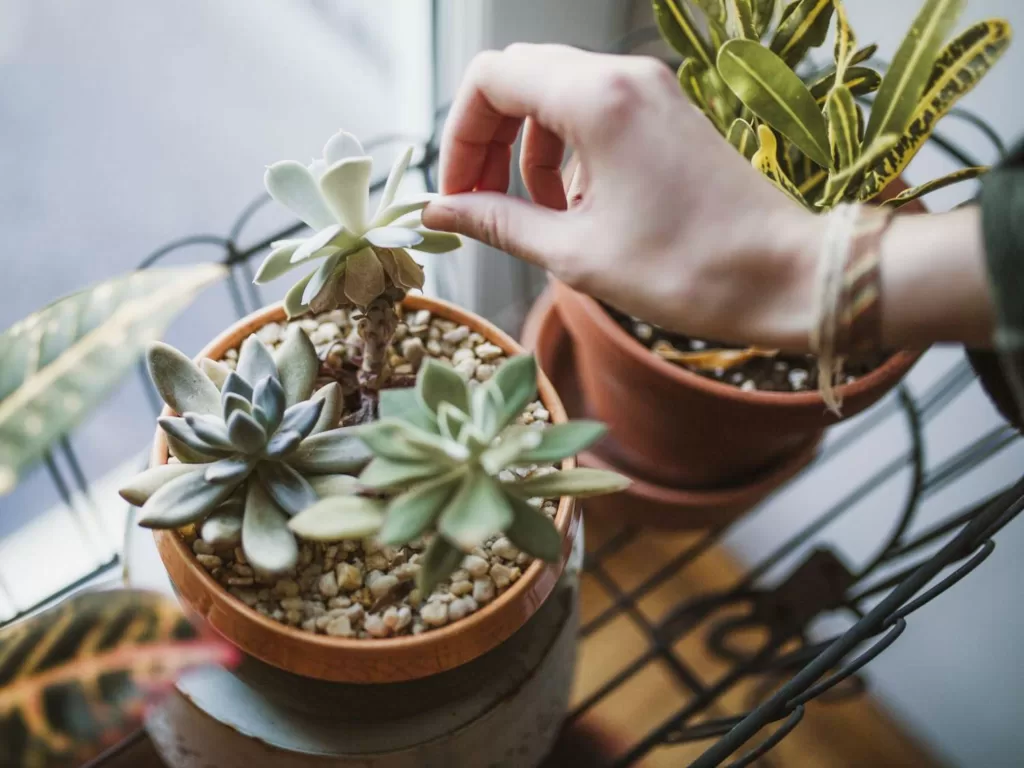Overwatered succulents can have a variety of symptoms, but some common signs include:
- Soft, mushy leaves
- Discoloration (brown or yellow) of leaves
- Rotting or decay at the base of the plant
- Soggy, heavy soil
- A mushy or foul smell from the soil
- Wilting or drooping, despite the soil being wet It’s worth noting that succulents can also show similar symptoms when underwatered, so it’s important to check the soil moisture and overall condition of the plant before making a diagnosis.
Table of Contents
What do unhealthy succulents look like?
Unhealthy succulents can have a variety of symptoms, depending on the cause of the issue. Some common signs of an unhealthy succulent include:
- Yellowing or discolored leaves
- Brown or black spots on leaves
- Wilting or drooping leaves, despite the soil being moist
- Soft or mushy leaves
- Rotting or decay at the base of the plant
- A mushy or foul smell from the soil
- White powdery substance on leaves (indicates a fungal or bacterial infection)
- Webbing on leaves (indicates an infestation of spider mites)
It’s worth noting that succulents can also show similar symptoms when overwatered or underwatered, so it’s important to check the soil moisture and overall condition of the plant before making a diagnosis.
It’s also important to note that succulents can be affected by pests and diseases that can also indicate an unhealthy succulent. These can include scales, mealybugs, or thrips.
In general, it’s important to observe your succulent regularly and take note of any changes in its appearance or behavior. If you notice any unusual symptoms, consult a succulent care guide or a local nursery expert for advice on how to proceed.

Do succulents like full hot sun?
Succulents, like most plants, need sunlight to survive, but the intensity and duration of sunlight that they can tolerate can vary depending on the species. In general, most succulents prefer bright, indirect light, rather than full hot sun.
Leaving a succulent in full hot sun for an extended period of time can cause sunburn or sun damage, which can result in discoloration, browning, or even death of the leaves. This can happen especially if the succulent is not gradually acclimated to the sun.
It’s best to place succulents in a location that receives bright, indirect light for most of the day, such as a south-facing window with sheer curtains or a spot that gets bright light for a few hours in the morning, but is shaded in the afternoon.
It’s also worth noting that some succulents are more tolerant of full hot sun than others. For example, species like Echeveria, Aeonium and Sedum can handle more sun than others like Haworthia, Gasteria or some types of Crassula.
It’s always best to do research on the specific type of succulent you have and observe its growth and appearance over time to know how much sunlight it prefers.
Is coffee good for succulents?
Coffee is not typically considered to be a beneficial substance for succulents. While some plants may benefit from the small amounts of nutrients found in coffee, succulents are generally not able to utilize these nutrients in a significant way.
Coffee is acidic and succulents prefer a slightly alkaline soil (around 7.0 pH) so if you pour coffee on the soil it could lower pH levels and make it harder for the succulent to absorb the nutrients it needs.
Additionally, the caffeine and other compounds found in coffee can be toxic to succulents, causing damage or even death.
It’s best to stick to using clean water or a balanced, well-draining potting mix for succulent care. In general, succulents prefer well-draining soil and infrequent watering, rather than being watered frequently.
It’s also important to note that succulents are sensitive to chemicals, so if you are using coffee grounds or any other form of coffee, make sure they are washed and clean of any chemical residues before using them.
In summary, coffee is not recommended for succulent care and it’s best to stick to using clean water and a balanced, well-draining potting mix for succulent care.

Do succulents in rocks need water?
Succulents planted in rocks do need water, but the amount and frequency of watering will depend on the specific conditions of the environment and the type of succulent.
Succulents are drought-tolerant plants and store water in their leaves, stems and roots, which allows them to survive for long periods without water. However, they still require water to survive, grow and thrive.
When planted in rocks, succulents may not have as much access to water as they would in soil, so they may require less frequent watering.
It’s important to note that succulents planted in rocks should be in well-draining soil, as they can easily rot if they sit in waterlogged soil. The soil should be allowed to dry out completely between watering.
A good way to check if your succulents in rocks need water is to poke your finger in the soil and see if the soil is dry or not. If the soil is dry, it is time to water. If the soil is still moist, wait a few more days before checking again.
It’s important to observe your succulent regularly and take note of any changes in its appearance or behavior. If you notice any unusual symptoms, consult a succulent care guide or a local nursery expert for advice on how to proceed.
It’s also worth noting that different succulent species have different water requirements, for example, some succulents like cacti, may need less water than others.
Can succulents be left in the rain?
Succulents can be left in the rain, but it’s generally not recommended. While most succulents are drought-tolerant and can survive extended periods without water, they are not well-suited to standing water or prolonged exposure to rain.
Prolonged exposure to rain can cause several issues for succulents. Firstly, the leaves of succulents can become waterlogged, which can lead to rot and fungal infections. Additionally, the excess water can cause the soil to become waterlogged, which can also lead to rot and fungal issues.
Furthermore, some species of succulents, like cacti, are adapted to dry conditions and they can also get sunburned if they are exposed to prolonged rain and sun.
It’s best to protect succulents from prolonged exposure to rain by placing them in a protected area, such as a greenhouse or covered patio. If you don’t have a protected area, you can also place a plastic cover over the succulents to protect them from the rain.
In general, it’s best to observe your succulents regularly, take note of any changes in their appearance or behavior and consult a succulent care guide or a local nursery expert for advice on how to proceed.







